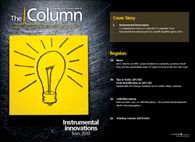The inspector's detector
The United States Food and Drug Administration in Irvine, California, USA has purchased the Dionex ICS-5000 ion chromatography system with mass spectrometer for the analysis of biogenic amines in fish samples.

The United States Food and Drug Administration in Irvine, California, USA has purchased the Dionex ICS-5000 ion chromatography system with mass spectrometer for the analysis of biogenic amines in fish samples.
Consumption of large amounts of biogenic amines, such as histamine, putrescine and cadaverine, can lead to allergic reactions in some individuals, and can also be life threatening in some cases. The US FDA has established a defect action level of 50 mg/kg histamine and a toxicity level of 500 mg/kg histamine in fish.
According to the manufacturer, the system is ideal for IC–MS analysis and applications of this type. The system flexibility and modularity is reported to provide the ability to analyse samples at capillary, microbore or standard flow-rates (or any combination of two in a dual system), and to configure an ion chromatography system specifically for the required solutions.
A range of food testing application notes are available from the company’s website, www.dionex.com under Markets/Food and Beverage/Food Safety.
This story originally appeared in The Column. Click here to view that issue.
Analytical Challenges in Measuring Migration from Food Contact Materials
November 2nd 2015Food contact materials contain low molecular weight additives and processing aids which can migrate into foods leading to trace levels of contamination. Food safety is ensured through regulations, comprising compositional controls and migration limits, which present a significant analytical challenge to the food industry to ensure compliance and demonstrate due diligence. Of the various analytical approaches, LC-MS/MS has proved to be an essential tool in monitoring migration of target compounds into foods, and more sophisticated approaches such as LC-high resolution MS (Orbitrap) are being increasingly used for untargeted analysis to monitor non-intentionally added substances. This podcast will provide an overview to this area, illustrated with various applications showing current approaches being employed.







